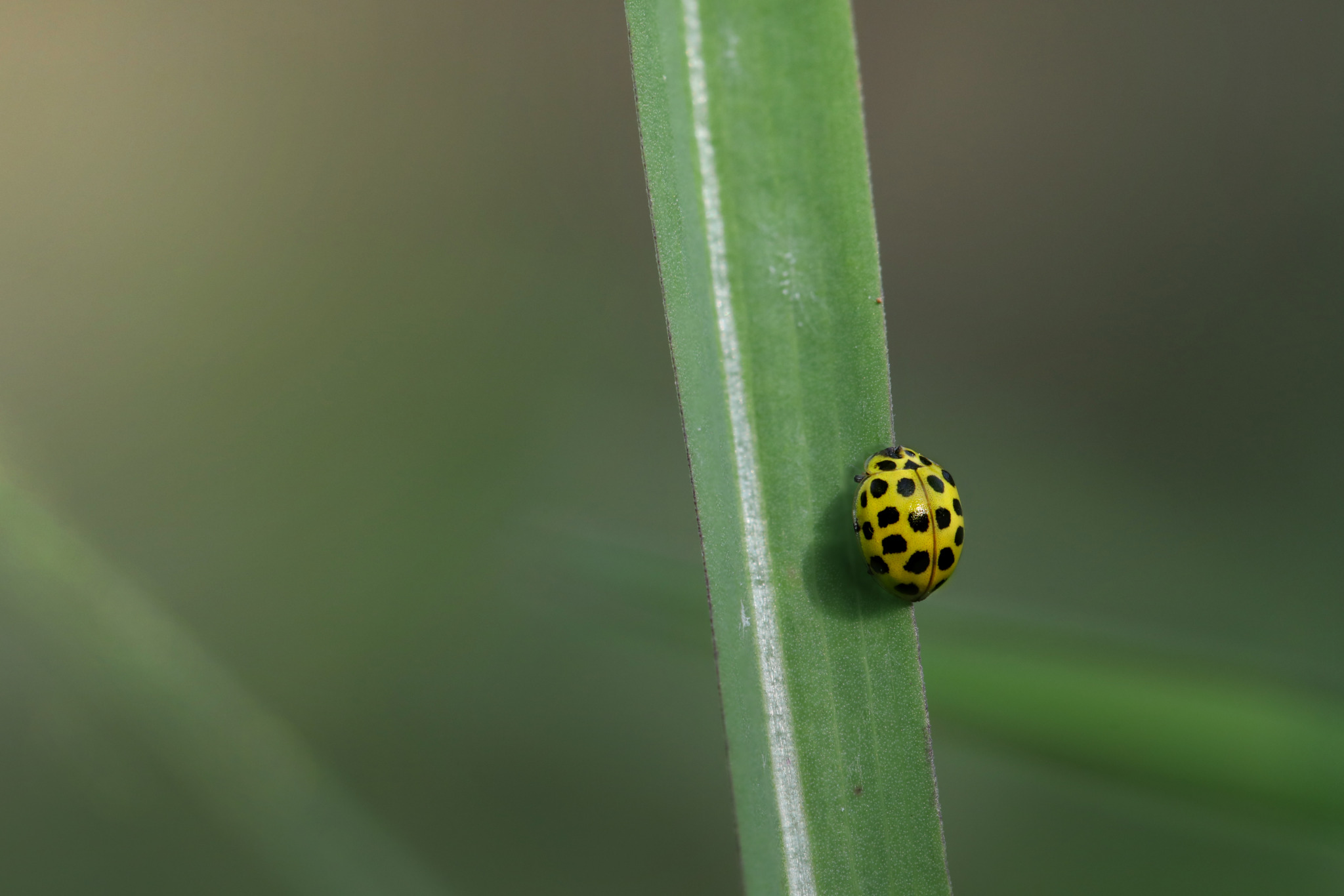The 22-spot Ladybird (Psyllobora vigintiduopunctata) is a small, brightly colored beetle that belongs to the family Coccinellidae, commonly known as ladybirds or ladybugs. Unlike many of its relatives, which are predators of aphids, the 22-spot ladybird is a mycophagous species, meaning it feeds on fungi. It is distinguished by its yellow body covered in exactly 22 black spots, making it one of the more easily identifiable ladybirds.
Physical Description:
- Size: The 22-spot ladybird is small, with adults typically measuring around 3–5 mm in length.
- Coloration: Its bright yellow body is its most striking feature. It has 22 round black spots arranged symmetrically across its elytra (wing covers) and pronotum (the area behind the head). The black spots on a yellow background give it a highly recognizable appearance.
- Body Shape: The beetle has the typical dome-shaped body of ladybirds, with a rounded, slightly convex appearance. It has short legs and antennae.
Behavior:
- Diet: Unlike the majority of ladybirds that are carnivorous and known for eating aphids and other plant pests, the 22-spot ladybird is primarily a fungal feeder. It feeds on mildew and other fungi found on the surfaces of plants, such as leaves, stems, and even tree bark. This dietary habit sets it apart from most other ladybird species.
- Activity: The 22-spot ladybird is active from spring through autumn and can often be found on low-growing vegetation, such as nettles, grasses, and various shrubs. It prefers damp environments where mildew growth is abundant.
Habitat:
The 22-spot ladybird thrives in habitats where its primary food source—fungal mildew—is plentiful. These environments include:
- Gardens: It is often found on garden plants with mildew, such as cucumbers or peas.
- Meadows: Wild grasses and plants in meadows frequently host the mildew that this species feeds on.
- Woodlands: Particularly in damp areas, the 22-spot ladybird can be seen on foliage with mildew, as well as on tree bark.
- Hedgerows: These areas provide shelter and a variety of plants with fungal growth that sustains the 22-spot ladybird.
Reproduction:
- Eggs: Female 22-spot ladybirds lay clusters of small, oval, yellow eggs on the undersides of leaves. The eggs are often deposited on plants where mildew is present, ensuring that the larvae have an immediate food source once they hatch.
- Larvae: The larvae of the 22-spot ladybird are dark-colored with light spots and spines, and they are also mycophagous, feeding on mildew. The larval stage lasts for a few weeks before they pupate.
- Pupation: After several larval molts, the larvae pupate and undergo metamorphosis into adult ladybirds. The pupal stage lasts about a week.
- Generations: The 22-spot ladybird has multiple generations each year, depending on environmental conditions, and can be seen throughout the warmer months.
Distribution:
The 22-spot ladybird is widespread across Europe, including the British Isles, and parts of Asia. It is also found in parts of North Africa. The species prefers temperate regions and is most commonly seen in areas with high humidity, where mildew grows abundantly.
Conservation Status:
The 22-spot ladybird is not considered endangered or at risk, and its populations are generally stable. It is classified as Least Concern by the IUCN, due to its wide distribution and adaptability to different environments. However, changes in agricultural practices and the use of fungicides could impact populations locally.
Interesting Facts:
- Fungal Feeder: Unlike most other ladybirds, the 22-spot ladybird does not prey on aphids but instead feeds on fungi, particularly powdery mildew. This dietary specialization makes it an important part of the ecosystem, as it helps control the spread of fungal diseases on plants.
- Bright Coloration: The yellow and black coloration of the 22-spot ladybird is a form of aposematism, where bright colors warn potential predators of its distastefulness. Like many ladybirds, it can secrete a foul-smelling fluid when threatened, deterring predators from eating it.
- Misidentification: Due to its small size and bright yellow color, the 22-spot ladybird is sometimes mistaken for other yellow insects, such as pollen beetles. However, its distinctive black spots make it easy to distinguish once closely observed.
Ecological Role:
The 22-spot ladybird plays a unique role in ecosystems as a mildew consumer. By feeding on fungi, it helps prevent the overgrowth of mildew on plants, which can damage plant tissues and reduce photosynthesis. Although its role is different from aphid-eating ladybirds, it is still beneficial for garden health and overall biodiversity.
Conclusion:
The 22-spot Ladybird (Psyllobora vigintiduopunctata) is a small but important species of ladybird, notable for its bright yellow color and distinctive 22 black spots. Its specialized diet of mildew sets it apart from its aphid-eating relatives, yet it still plays a crucial role in maintaining plant health by controlling fungal growth. Widely distributed across Europe and parts of Asia, this charming little beetle is a fascinating example of the diversity within the ladybird family.
Views: 1301
Subscribe to the newsletter:
